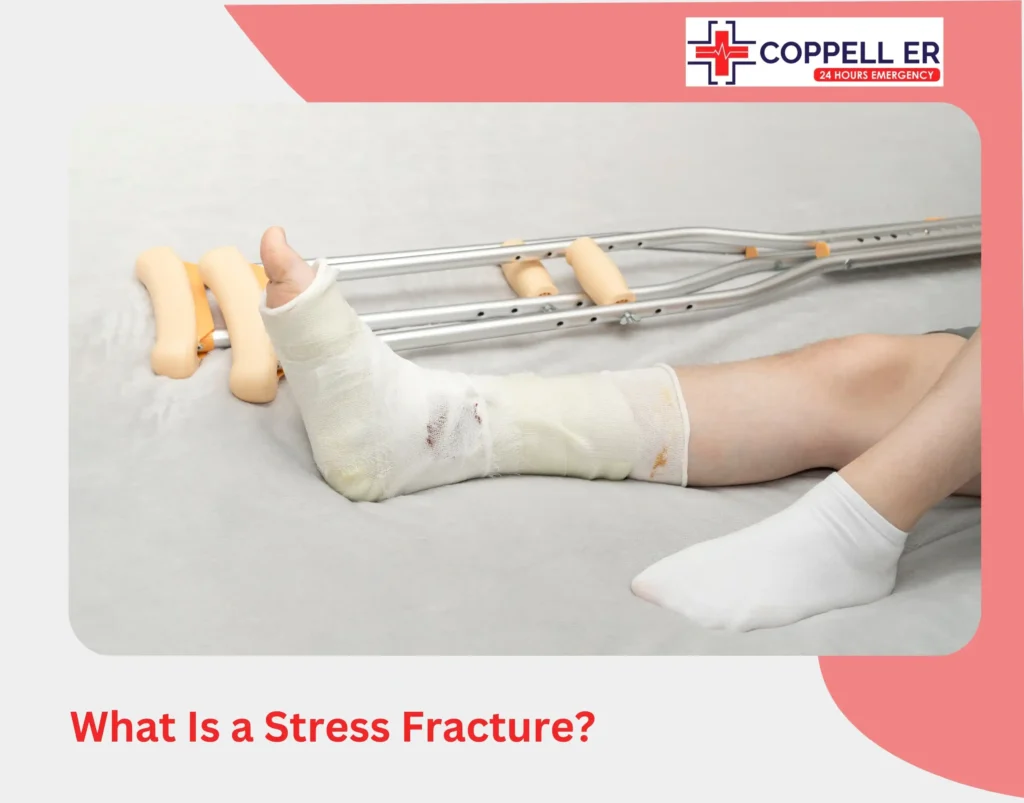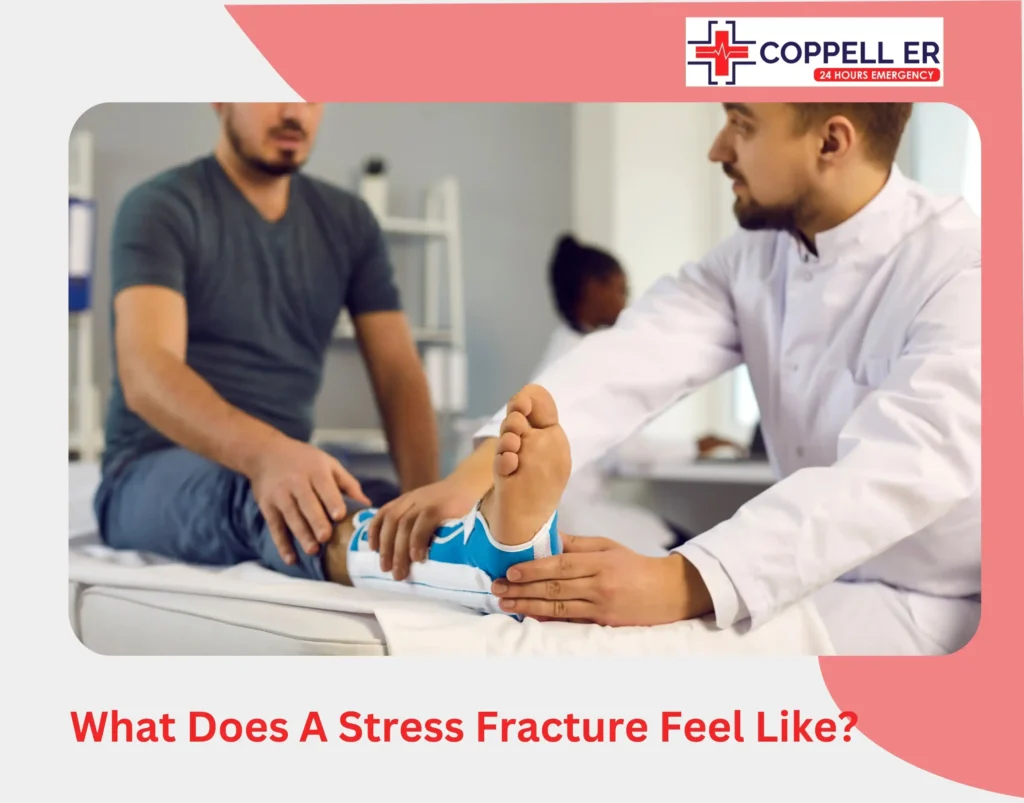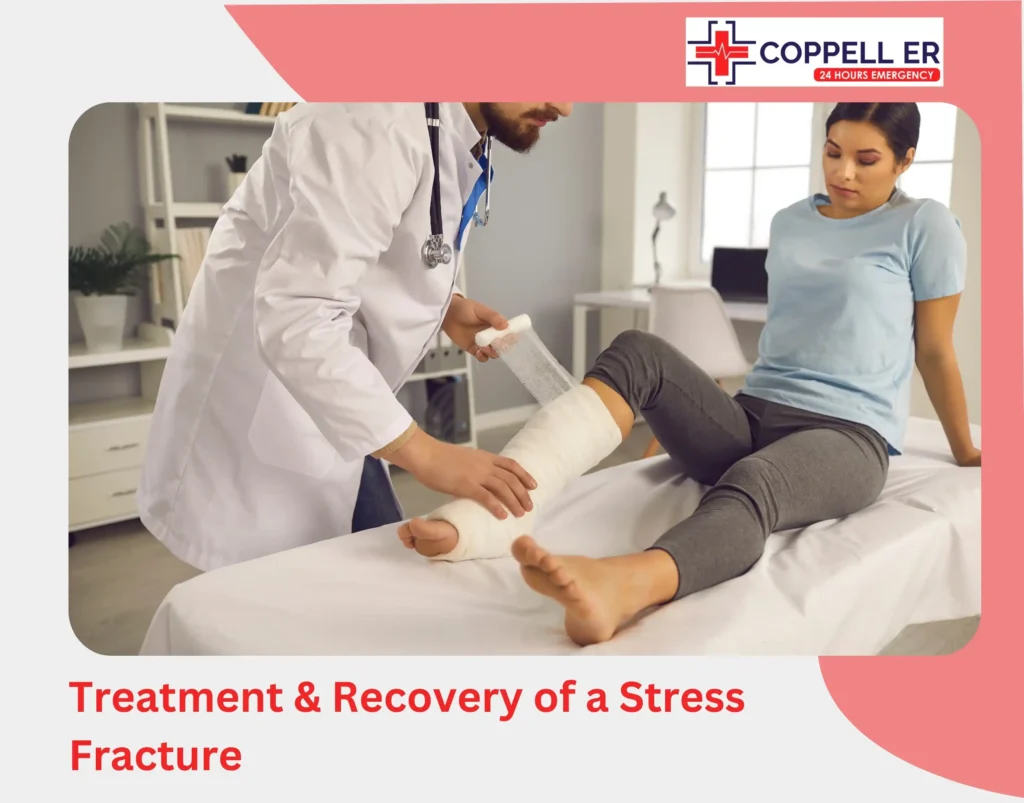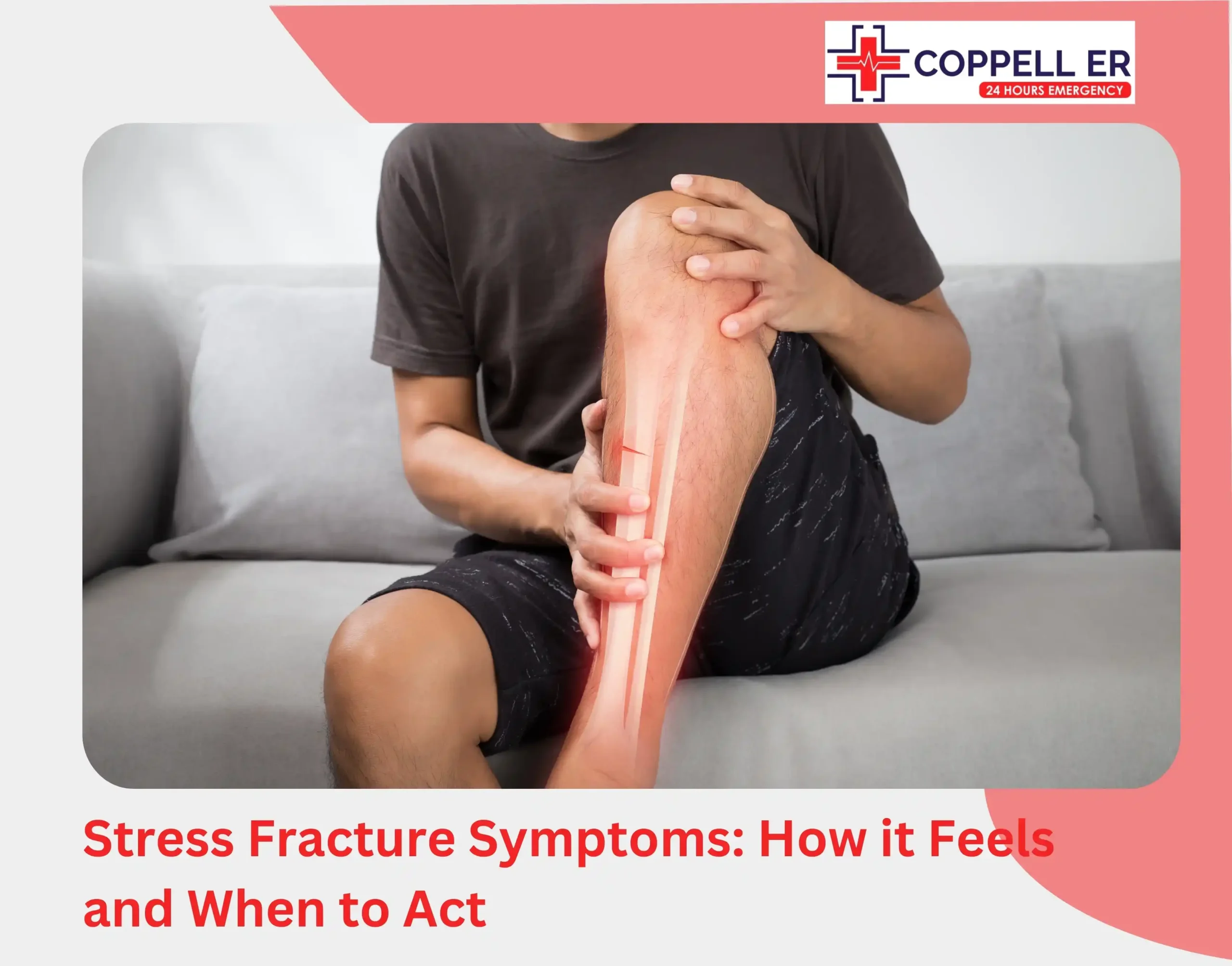Worsening foot pain could be more than just soreness from your morning jog. A stress fracture might be developing beneath the surface. A stress fracture is a tiny crack, often caused by repetitive stress on the bone. If you keep using the injured bone like nothing’s wrong, it can fully break.
The difference between catching a stress fracture early means two weeks of rest. Wait too long, and you could be in a cast for two months.
To help you avoid that trouble, let’s talk about what stress fractures are, stress fracture symptoms, and when it’s time to stop pushing through the pain and get help.
What Is a Stress Fracture?

Unlike bone break where you remember a clear moment, a stress fracture builds up over time. It is a small crack in a bone that usually happens from repetitive force or overuse. It feels like a dull, persistent pain that worsens with activity and may improve with rest.
Your bones are alive, not just hard, dead material. Every day, when you’re walking or exercising, tiny amounts of damage happen inside your bones.
That’s normal. Your body is constantly repairing those small damages without you even noticing. Stress fractures occur when your bones are pushed beyond their ability to repair themselves.
How Does a Stress Fracture Happen?
This often happens due to the following reasons:
- Overtraining: Doing too much, too soon, especially with high-impact activities like running or basketball, doesn’t give your bones time to adapt.
- Poor Bone Health: Conditions like osteoporosis or vitamin D deficiency make bones weaker and more prone to injury.
- Foot Problems: Flat feet, high arches, or improper gait can shift pressure to certain bones and increase the chance of stress fractures.
- Inadequate Footwear: Old or poorly cushioned shoes can’t absorb shock, which transfers stress to your bones.
Common Locations for Stress Fractures
Stress fractures are common in weight-bearing bones such as:
- Metatarsals (bones in your foot, especially the second and third)
- Tibia (your shinbone)
- Fibula (the smaller bone next to your shin)
- Heel (calaneus)
- Hip and pelvis
- Lower back (in some athletes)
Who’s Most at Risk of Stress Fractures?
Here’s a breakdown of the biggest groups whose daily routines involve repetitive stress on bones:
- Runners: They repeatedly impact the feet, shins, and hip bones. A sudden increase in mileage or intensity is a huge trigger for stress fractures. Stress fractures account for up to 16% of all injuries in runners.1
- Athletes: Sports like basketball, soccer, gymnastics, dance, and tennis involve frequent jumping, quick starts/stops, and pounding on hard surfaces.
- Military Recruits: Known as “march fractures,” stress fractures are common in military training due to rigorous training regimens.
- People with osteoporosis or low bone density: Your bones may not be strong enough to handle repetitive impact.
- Those increase activity too quickly: If you go from the couch to 5K too fast, your body may not be ready.
- Poor nutrition: Your bones need nutrients like calcium and vitamin D to stay strong.
Women with irregular periods: Irregular periods, particularly amenorrhea (absence of menstruation), lead to lower estrogen levels (a hormone vital for bone health). Women with these issues are at significantly higher risk of stress fractures due to weakened bones.
What Does A Stress Fracture Feel Like?

A stress fracture feels like a dull, persistent ache that worsens the more you use the injured area. Some stress fracture symptoms include:
- It starts dull and gets worse. At first, the pain only shows up during activities (like running, jumping, or walking long distances).
- It’s in a specific spot. Unlike muscle soreness, which is more spread out, stress fracture pain is in a small, pinpoint area.
- It may continue at rest. As it gets worse, the pain can stick around even when you’re not putting weight on it.
- You might notice mild swelling over the area.
- You don’t remember a specific injury. As they come from repetitive use or overtraining, not from a fall or accident.
How Is a Stress Fracture Diagnosed?
Here’s how a stress fracture is diagnosed at emergency room:
- Medical History: Your doctor asks questions like “Did you recently change your workout routine or activity level?”; “Are you training for a race or starting a new job that involves standing or walking a lot?”
- Physical Examination: A key clue is to press along the bone to check for tenderness in a specific spot. Also, the doctor looks for swelling, redness, or any visible signs of stress.
- Imaging Tests: Tests like X-rays, bone scans, or CT scans help confirm the fracture.
- Lab Tests: If the doctor suspects your bones may be weaker they may check calcium and vitamin D levels, bone density scan (DEXA), and hormone levels, especially in women with irregular periods.
Treatment & Recovery of a Stress Fracture

Most fractures heal with proper rest and care. Depending on the severity and location, stress fractures treatment may include:
- Rest Is Your First Medicine: Cease running, jumping, and other such activities for at least six weeks. Always consult with your doctor before going back to high-impact activities.
- Protect the Area: A walking boot or brace takes pressure off the area. You may also use crutches to avoid putting weight on the injured limb.
- Manage Pain and Swelling: Use ice packs on the injured area (15–20 minutes at a time). The doctor may also give over-the-counter pain relievers.
- Support Your Bones From the Inside: Make sure your bones get the right nutrients; calcium, vitamin D, and protein to heal well.
- Gradual Return to Activity: Once your doctor gives you the green light, you’ll slowly ease back into movement.Here’s how you can progress week by week.
| Week | What You Should Do |
| 1–2 | Complete rest, elevation, ice, possibly crutches or a boot |
| 3–4 | Light activities (like swimming, upper body exercise) if approved |
| 5–6 | Begin gentle weight-bearing if pain-free |
| 6–8+ | Gradual return to walking, biking, or low-impact workouts |
| 8–12+ | Slowly reintroduce running, jumping, and sports after full healing |
Note: If you rush it, you risk re-injury or a full fracture, which could double your healing time.
Final Thoughts
An untreated stress fracture can turn into a complete break. That means more pain, a longer recovery, a sedentary life, and extra money spent. So, don’t wait for your pain to get worse when you feel stress fracture symptoms.
You don’t have to drive far with a painful foot. ER Coppell is right here in your neighborhood, open 24/7. You’ll be back on your feet in no time with our advanced imaging and expert care.
FAQs
1. How long does a stress fracture take to heal?
Most stress fractures usually take 6 to 8 weeks to heal with proper rest. More severe cases of fractures in areas with poor blood flow (like the navicular bone in the foot) may take longer.
2. Can you walk with a stress fracture?
Yes, but you shouldn’t. While you might still be able to walk with a stress fracture, doing so can worsen the injury and turn a small crack into a full-blown break.
3. Can stress fractures heal on their own?
Technically, yes, But only if you rest properly and stop the activity causing the stress. If you keep pushing through, the fracture can get worse.
4. Are stress fractures more common in one foot than the other?
Not always, but they often occur in the dominant leg (the one you lead with), or the foot that absorbs more impact from running or jumping.
5. Can kids or teens get stress fractures?
Absolutely. Active kids, especially in gymnastics, running, or dance, can get stress fractures, especially when bones are still developing.
6. Can stress fractures be prevented?
Yes! Good footwear, gradual training increases, strength training, and proper nutrition (especially calcium and vitamin D) reduce your risk.




